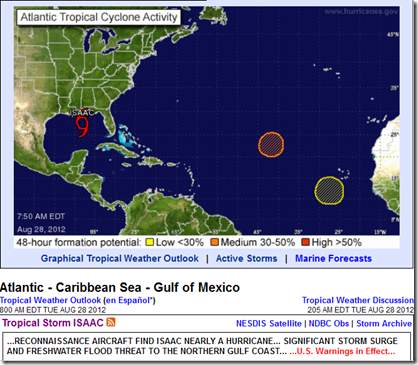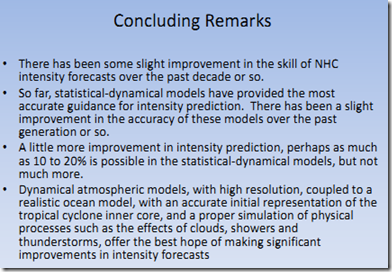 Source NHC
Source NHC
# 6521
The 8am EST advisory from the National Hurricane Center finds Isaac close to hurricane strength this morning as he slogs towards the northern Gulf coast at 7 miles per hour. Isaac will be pushing substantial storm surge (6-12 feet) towards the coast, along with high winds, rain, and the potential for tornadoes.
Hurricane or not, Isaac remains a serious threat and is deserving of respect.
Two days ago forecasters had already accurately predicted a Louisiana/Mississippi landfall - but they also expected Isaac to a strong CAT 2 storm by now. At least one model (HWRF) suggested a low CAT 3 intensity.
So what happened?
While forecast path prediction has come a long ways in the past 30 years, comparatively little progress has been made in intensity predictions.
The number of atmospheric, oceanic, and land influences on budding tropical systems make it very difficult – with today’s technology – to accurately predict intensity changes 24 to 48 hours out.
We’ve often seen storms fail to reach their predicted potential, while others have rapidly intensified beyond any reasonable expectations.
Unexpectedly, Hurricane Charlie jumped from a CAT 2 storm to a CAT 4 storm in a matter of a couple of hours just before slamming into Southwest Florida in 2004.
This vexing subject was the topic of a presentation last year at the National Hurricane Conference.
It’s a fascinating 22-page document, but the upshot is, there’s not much hope that intensity forecasting is going to catch up with the recent gains in track forecasting anytime soon.
All of this uncertainty over storm intensity makes life very difficult for emergency managers. They must decide – 48 hours in advance of a storm – whether to call for evacuations.
And the stakes are very high.
Evacuations are expensive, horribly inconvenient, and have the potential to claim more lives than the storm itself. During the evacuation of the Texas Gulf coast in advance of Hurricane Rita in 2005, more than 90 people died.
And storms that failed to live up to their billing only serve to convince people not to evacuate the next time a storm threatens.
Be glad it isn’t your call.
In time, intensity forecasting will hopefully improve. But tropical storms and hurricanes are complex and dynamic systems, and will probably always have the ability to throw us a curve.
All of which highlights the importance of individual, family, and community preparedness. We must always be prepared for the unexpected.
National Preparedness Month is just a few days away, and the folks at FEMA, and READY.GOV would like to encourage you to learn how to make a plan, build a kit, and be informed.
And all next month I’ll be featuring preparedness articles in my blog.



